Understanding Chicken Feeding Costs: A Complete Guide
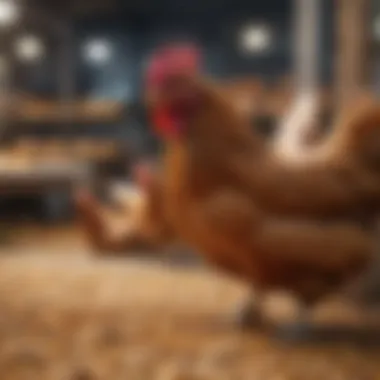
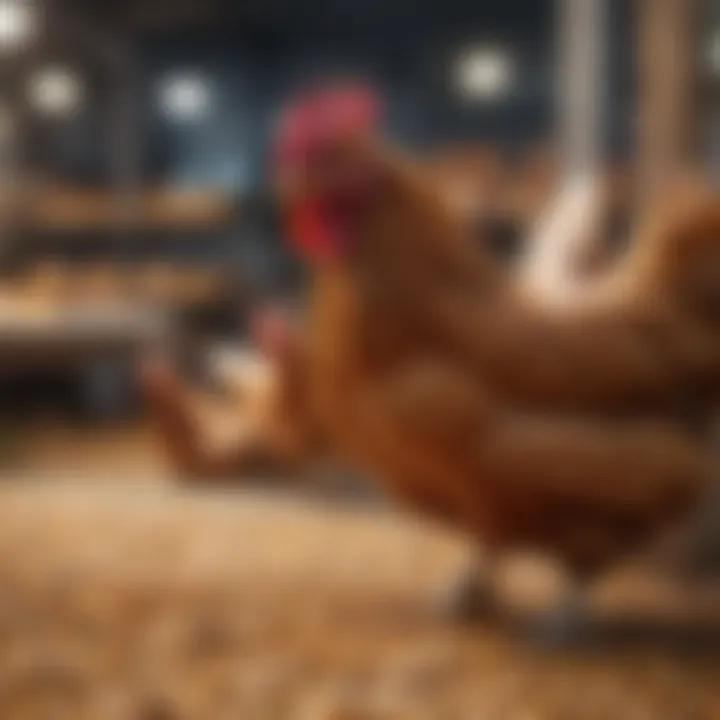
Intro
Feeding chickens may seem straightforward, but when you peel back the layers, the complexities multiply. The cost of feeding these birds extends beyond simply buying a bag of feed. From the nutritional needs of different breeds to the nuances of seasonal variations, each aspect plays a crucial role in forming a coherent picture of poultry nutrition. This guide aims to illuminate those considerations, offering insights that every chicken owner should grasp.
Understanding not just the face value of feed prices, but also hidden expenses such as supplements, treats, and unforeseen medical costs, empowers owners. It helps ensure chickens thrive while keeping financial sustainability in check.
Health and Nutrition
Health and nutrition are two sides of the same coin when it comes to poultry care. Feeding your chickens a balanced diet is essential not just for growth, but for their overall well-being. From chick stages to laying hens, the nutritional requirements shift. This section outlines various facets of chicken nutrition to help owners make informed choices.
Understanding Chicken Nutrition
Chickens require a mix of proteins, vitamins, and minerals. Layer feed is often high in calcium while broilers need protein-rich diets. It’s important to simply understand that not all feeds are created equal. Look for key ingredients like corn, soybean meal, and essential vitamins to ensure robust health.
Common Health Issues
While feeding your chickens, keep an eye on common health issues. Problems like pecking order disputes or health ailments like avian flu can arise.
"An ounce of prevention is worth a pound of cure." – This old saying rings true when it comes to chicken health. Regular check-ups and a keen eye for signs of distress will save costs in the long run.
Preventive Care and Regular Check-Ups
Scheduled veterinary care can be a real money-saver. It may seem like a drain at first, but catching issues early avoids larger expenses later. Make sure your flock is receiving adequate vaccinations and treatments for parasites.
Food and Dietary Advice
Incorporating scraps and treats into a chicken's diet can sometimes present hidden savings. Leftovers can reduce feed costs and provide enrichment, but it’s essential to ensure any additional food is safe.
Pet Care and Grooming
While it seems off-topic, grooming and care are also part of healthy chicken feeding. It affects not just the bird health, but also how efficiently they're able to process and benefit from their feed.
Importance of Regular Care
Chickens, like any live animal, require routine care. This includes cleaning their coops and ensuring bedding is dry and fresh, both of which contribute positively to their feeding efficiency.
Tools and Products Recommendations
Investing in proper feeding tools can save both money and time. Consider things like automatic feeders that minimize waste by providing precise amounts of feed, which helps control expenses. Additionally, using waterers that limit evaporation or contamination will ensure chickens remain hydrated without needing constant refills.
Seasonal Care Tips
Every season presents unique challenges. Cold weather may require high-energy feeds, while hot climates demand attention to water consumption. Understand the environmental factors so you can adjust feeding strategy accordingly.
Engaging Activities and Enrichment
Chickens also need mental stimulation, not just physical health. Providing play and engagement can reduce stress and enhance feed conversion efficiency.
Fun Games to Play with Your Chickens
Here’s a thought: try to scatter scratch grain in different areas of their pen. It encourages foraging, keeping them active and happy.
Importance of Mental Stimulation
Just like us, chickens can get bored. Without some form of entertainment, they may resort to undesirable behaviors that could impact their health and eating habits.
Resources and Community Engagement
The journey of feeding chickens can be a winding road. Getting involved with communities and resources can provide support and guidance.
Recommended Books and Websites
Books like "Storey's Guide to Raising Chickens" offer thorough insights into feeding and caring for your flock. Online platforms such as Reddit or community Facebook groups are also invaluable for tips and shared experiences.
Finding Local Services and Classes
Local farmers often have pools of knowledge to draw from. Engage with your community, attend workshops, or find classes dedicated to poultry care to stay informed and connected.
Preface to Chicken Feeding Costs
Feeding chickens isn’t just about tossing some grain in a trough and calling it a day. It's a multifaceted endeavor that has far-reaching implications for both the health of the birds and the finances of their keepers. Understanding the costs associated with feeding chickens is critical for anyone dabbling in poultry farming, whether for meat, eggs, or even as a hobby. A sound grasp of feeding costs allows for more effective budgeting, ensuring that every penny spent translates into healthier, more productive birds.
Importance of Proper Nutrition
Nourishment is the backbone of any successful poultry operation. Chickens require specific nutrients for optimal health, egg production, and growth. When they don’t receive adequate nutrition, it can lead to a host of problems, including poor weight gain, reproductive issues, and increased vulnerability to diseases. Proper nutrition may seem like an additional expense upfront, but it can save owners from expensive vet bills and loss of production down the line. Understanding nutritional needs might also inform the choice of feed types, which can vary significantly in cost.
Moreover, different life stages of chickens require varying diets, from starter feed for chicks to layer feed for hens. A nuanced comprehension of their dietary needs can yield better results in both performance and health, leading to higher quality eggs and meat.
General Overview of Costs
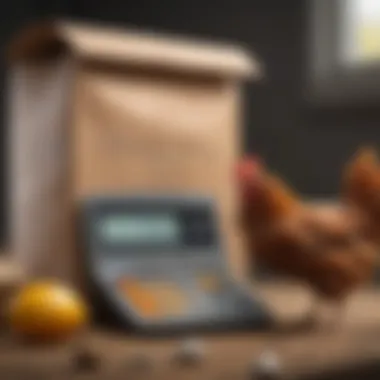
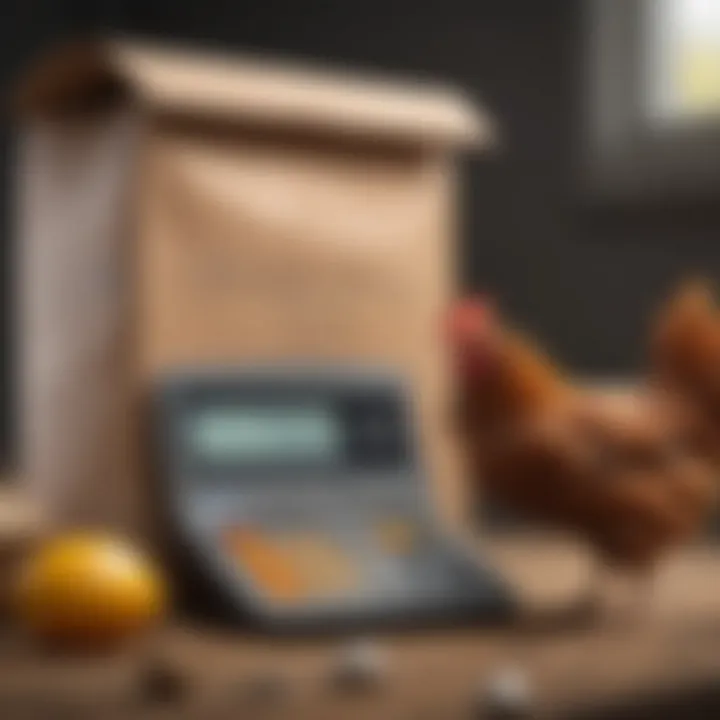
The cost landscape of feeding chickens is as varied as the diets you might feed them. On average, owners can expect to budget between $20 to $50 a month per flock of chickens, depending on various factors, including feed type, quality, and local prices. The major expense often stems from commercial feeds, which can vary in quality and price points. Buying in bulk generally allows for some cost savings, but initial expenses can strain pocketbooks if not carefully managed.
Here are some factors that typically influence chicken feeding costs:
- Type of Feed: Layer feed, grower feed, and starter feed all come with different price tags.
- Local Prices: Buying locally produced feed might save money, but imported options could offer a wider variety.
- Supplementary Additives: Vitamins, minerals, and other enhancements can add to the basic cost of feed.
In addition to the primary feed cost, owners should also keep an eye on potential hidden expenses, such as the need for supplements or changes in market prices.
"Understanding feeding costs is not merely about numbers; it’s about investing in the long-term health and productivity of your chickens."
Having a thorough breakdown of costs not only equips chicken owners with essential information for budgeting but also enhances their ability to assess the effectiveness of their feeding strategies.
Factors Influencing Feeding Costs
In the journey of keeping chickens, feeding costs can be a considerable part of the budget, and understanding the factors influencing these costs is imperative for any poultry keeper. There are several elements that can directly affect how much one spends on chicken feed, from the type of feed chosen to the method of feeding. By exploring these factors, one can make informed decisions that maintain the health of their flock without breaking the bank.
Types of Feed Available
Different types of feed serve specific purposes in the life stages of chickens. Getting acquainted with the varieties like layer feed, grower feed, and starter feed can help you to navigate the cost landscape effectively.
Layer feed
Layer feed is specially formulated for hens that are laying eggs. This type of feed is generally high in calcium to support eggshell formation and enriched with proteins to ensure your birds remain healthy and productive. It's a critical investment, as the quality of layer feed directly affects both the quantity and the quality of eggs produced.
One standout feature of layer feed is its balance of nutrients. Many commercial brands also emphasize the presence of essential amino acids which can lead to better egg production. However, the price tag often reflects the quality. Higher-quality layer feeds may seem pricey upfront but often result in healthier birds that produce more eggs over time, making it a wise long-term investment. On the flip side, cheaper options might save a few bucks initially but can lead to deficiencies or poor growth inlaying hens, ultimately costing more in the long run.
Grower feed
Grower feed is designed for chickens that are too young to lay eggs but have outgrown the starter phase. This feed typically contains a balanced ratio of proteins, fats, and vitamins to ensure optimal growth. As chickens transition from chicks to adults, this type of feed becomes vital for their development.
Its key characteristic lies in the protein content, which is kept higher to support muscle development. The distinctive aspect of grower feed is that it can help reduce waste due to its design to meet the specific growth needs of chickens. However, some growers might find this feed pricier than starter feeds, but it yields better results, making it more than just a cost-saving decision.
Starter feed
Starter feed is essential during the early weeks of a chicken's life. It’s packed with essential nutrients necessary for healthy growth and development. With high concentrations of protein, it helps ensure that chicks grow robustly during their critical formative stages.
One feature of starter feed is its fine texture, designed so that young chicks can easily consume it. This ease of consumption is a boon, as it can lead to better growth rates and reduce mortality in young birds. Although starter feed may appear to be one of the less expensive options upfront, the capital you invest now can translate to healthier and more productive birds later on.
Quality of Ingredients
The quality of ingredients used in chicken feed plays a substantial role in determining both the price and the effectiveness of the feed. Understanding the differences between organic and conventional feeds can significantly influence annual feeding costs.
Organic vs. conventional
Choosing between organic and conventional feed isn’t just about cost; it’s also about health benefits for both chickens and consumers. Organic feed is free from synthetic pesticides, herbicides, and antibiotics, promoting the health of Hen and reducing environmental impact. Additionally, organic eggs often fetch a higher price in the market, presenting a potential return on investment for chicken owners.
However, organic feed generally comes at a premium price, making it a more significant investment upfront. If you are solely looking to keep a small backyard flock, this cost might be justifiable considering the chickens' health and quality of eggs produced. On the other side, conventional feed is often less expensive and readily available, so for many chicken keepers, it becomes a practical choice.
Local vs. imported
Sourcing feed locally can often save a substantial amount of money due to lower shipping costs. Local feeds typically consist of fresh, regional ingredients, which not only supports local farmers but may also provide a nutritional edge compared to imported feeds, which can sometimes sit in storage for extended periods.
However, imported feed can provide specific formulations not readily available locally. Thus, while local options are generally cost-effective and fresher, imported varieties may cater to those looking for specialized nutrient profiles that local brands can’t provide.
Feeding Methods and Their Impact
How you choose to feed your chickens is another key aspect influencing the overall cost. Different feeding methods can lead to varying expenses, stressing the need for careful consideration.
Self-feeding systems
Self-feeding systems offer a convenient way to keep feed available for chickens throughout the day. This method involves the use of feeders that allow birds to access feed on their own, reducing time spent on feeding. This convenience can lead to lower labor costs, making it an attractive option for larger properties with many chickens.
However, the downside is that self-feeders can lead to overconsumption, especially if the feed isn’t correctly portioned or if feed quality is poor. An extra factor to consider is the initial investment in high-quality feeders, which might appear daunting but can lead to overall savings in the long run.
Free ranging
Allowing chickens to free range can significantly reduce feed costs as they will forage naturally. This method encourages chickens to find insects, plants, and seeds, providing a varied diet and reducing reliance on commercial feed. This method promotes natural behaviors, resulting in healthier animals.
Yet, free-ranging also has its downsides. Your chickens may become more susceptible to environmental dangers such as predators, and reducing feed can lead to nutritional deficiencies if not managed properly. Additionally, the availability of forage can vary widely depending on the season. Balancing the benefits with potential risk is essential for sustainable chicken feeding.
Average Costs for Commercial Feed
When it comes to raising chickens, the average costs for commercial feed can play a pivotal role in the overall budget. A detailed understanding of these costs is essential for any chicken keeper, be they a seasoned farmer or a backyard hobbyist. Different types of feed vary significantly in price and nutritional value, which makes evaluating your feeding strategy not just about savings, but also about ensuring the health and productivity of your flock. Each dollar spent can have a substantial impact on your chickens' well-being, thus influencing egg production and meat quality.
Price Ranges for Different Feed Types
The price of commercial chicken feed fluctuates based on several factors, including the type of feed, regional availability, and quality of ingredients. Typically, you can expect to encounter three main categories of chicken feed:
- Layer feed: This is usually priced between $15 to $25 per 50-pound bag. It’s designed to provide the necessary nutrients for hens to produce eggs efficiently.
- Grower feed: Ideal for the developmental stage of chickens, this feed ranges from $14 to $22 for a similar size bag. It's suitable for younger birds who need more protein for growth.
- Starter feed: This often costs around $16 to $24 and is specifically formulated for chicks, offering the nutrients they need for healthy development.
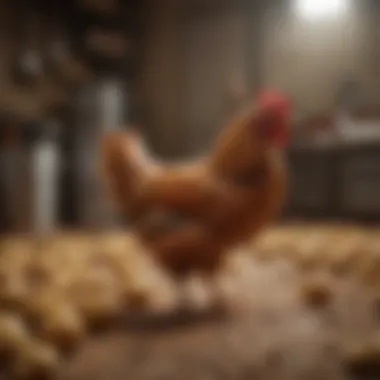

It's worth noting that while the initial costs may seem higher for certain feeds, they can save you money in the long run by promoting better health and increased productivity.
Comparative Analysis of Brands
When diving into commercial feed, a comparative analysis of brands is crucial. Not all feeds are created equal, and even within the same type of feed, quality can vary significantly.
- Purina Layena: Renowned for its balanced nutrition with added vitamins and minerals; this brand delivers good results but comes with a higher price tag, often near the upper end of the price ranges mentioned earlier.
- Dumor Layer Pellets: More budget-friendly, Dumor offers a solid nutritional profile at a lower price. However, some users report varying satisfaction in terms of egg production and overall bird health.
- Manna Pro: This brand provides organic options that might appeal to those who prioritize natural ingredients. Its pricing is competitive, but it can lead to increased costs for those looking to feed larger flocks.
Ultimately, choosing the right brand comes down to not just cost but also personal preferences, flock needs, and long-term health considerations. Monitoring your chickens' response to their diet, and keeping track of how they perform, can inform future purchasing decisions.
"Understanding feed pricing is as essential as ensuring your chickens have access to quality nutrition."
Being mindful of both price and brand can help manage your feeding costs effectively, which is a critical concern no matter how many birds are in your coop.
Assessing Additional Costs Associated with Feeding
When it comes to the finances surrounding feeding chickens, there’s more than just the price of feed to consider. Accurately assessing additional costs is pivotal for ensuring that your poultry diet is both effective and economical. This not only pertains to feed alone but also includes various factors that can influence overall expenditures. Understanding these components helps you avoid surprises down the line and encourages you to make informed choices that benefit both your chickens and your wallet.
Supplements and Additives
Vitamins and minerals
Vitamins and minerals play a key role in maintaining the health and productivity of chickens. Essentially, these nutrients are vital for growth, egg production, and overall wellbeing. A well-balanced diet should ideally incorporate these supplements to plug any nutritional gaps that typical chicken feed might leave. An essential characteristic of vitamins and minerals is their ability to enhance the birds’ immune system. This is particularly beneficial for ensuring that your chickens are resilient against infections and diseases.
The unique feature of these additives is they can be tailored to meet specific needs. For instance, adding calcium can improve eggshell quality, whereas providing Vitamin A can support vision and skin health. However, it’s important to tread carefully. Over-supplementation may lead to imbalances that could be harmful. So, while the investment in vitamins and minerals seems beneficial at first glance, it requires attentive adjustments based on your chicken's health and production profile.
Probiotics
Probiotics have garnered attention for their positive impact on gut health in chickens, enhancing digestion and nutrient absorption. The key characteristic of probiotics is their ability to maintain a healthy balance of flora in the digestive tract, which can be particularly important if birds are undergoing stress or dietary changes. This isn’t just against common ailments; it’s about fostering a balanced ecosystem within your flock.
A unique aspect of probiotics is their varied forms. They can come in powders or liquid forms and can be added to feed or water, providing flexibility in how you incorporate them. Nevertheless, while they are widely praised for promoting health and increasing efficiency in converting feed to meat or egg production, the cost can add up quickly, especially if you use premium products. It's essential to weigh the overall health benefits against the financial outlay to see if they fit into your feeding strategy.
Water Costs and Considerations
Water may seem trivial compared to feed costs, but its role in poultry nutrition is enormous and should not go unnoticed. Chickens require plenty of fresh, clean water daily, and the costs related to providing this necessity can accumulate over time. Factors influencing water costs include the source of water, type of infrastructure for delivery, and potential treatment options for ensuring quality.
Neglecting proper water provision can lead to less efficient feed conversion and lower productivity. For example, during hot weather, chickens need more water, and without a sufficient supply, their performance could severely decline. Thus, considering water costs is an integral part of budgeting, as it directly impacts the overall health and output of your chickens.
Storage Solutions for Feed
Efficient storage of feed is crucial for both cost management and animal health. Proper storage can prevent spoilage and pest infestations, which can eat into your budget in unexpected ways.
Bins and containers
Using bins and containers for chicken feed storage is essential. Opting for air-tight, durable containers prevents moisture and pests from ruining your feed. One of the key benefits of using these storage solutions is their ability to keep feed fresher for longer. This characteristic not only reduces waste but also means your chickens receive the nutritional value intended. Moreover, readily available options can cater to varying sizes of flocks, making it easier to manage feed efficiently. However, upfront costs for high-quality bins may seem steep, but over time, they will save you money by minimizing feed loss.
Proper storage techniques
Proper storage techniques can make or break your budget. Keeping feed in a cool, dry place away from sunlight is paramount to extending its shelf life. One major characteristic of effective storage techniques is simplicity; stacking containers while ensuring ventilation can create both organization and accessibility. However, it’s not always a smooth road. If these techniques aren’t implemented properly, you risk attracting rodents or molding feed, which can amplify losses significantly. Regular checks and adjustments to your storage methods can help you maintain the balance between convenience and cost savings.
"Proper management of feed storage can save considerable money in the long run, preventing waste and boosting flock health."
In summary, assessing additional costs associated with feeding involves considering these various factors beyond buying basic feed. From understanding the role of supplements and water to implementing effective storage methods, each element plays a significant role in the overall cost-effectiveness and health of your chickens.
Budgeting for Chicken Feeding
When keeping chickens, it's easy to get swept up in the excitement of selecting breeds or planning coops. However, one of the most crucial aspects often falls through the cracks: budgeting for chicken feeding. A solid budget not only helps manage ongoing costs but also ensures your flock stays healthy and productive.
In the end, cost management can be the difference between enjoying a steady stream of eggs or facing regrettable financial strains. Implementing a sound feeding budget offers several benefits, including:
- Controlled Spending: By planning how much you’ll spend on feed monthly or annually, you reduce the risk of overspending.
- Nutritional Balance: Allocating funds wisely allows for the purchase of high-quality feed that meets your chickens’ nutritional needs.
- Stress Mitigation: Knowing you have a plan alleviates the anxiety of unexpected costs.
Establishing a Feeding Budget
Establishing a feeding budget starts with understanding your flock size and consumption rates. Each chicken consumes a certain amount of feed daily, so knowing their needs is essential. An average laying hen typically eats about 0.25 pounds of feed per day. Here's a simple way to calculate your feeding budget:
- Count the number of hens. Let's say you have 10.
- Multiply the number of hens by the daily feed consumption (10 hens x 0.25 pounds = 2.5 pounds of feed per day).
- Multiply the daily feed by the number of days in a month (2.5 pounds x 30 days = 75 pounds monthly).
- Finally, multiply this by the cost of your chosen feed. If feed costs $15 per 50 pounds, the monthly feed cost equals around $22.50.
In this example, knowing the daily and monthly needs not only makes estimating costs manageable but also ensures that you're adequately supporting your chickens’ health.
Long-term Cost Considerations
When budgeting for chicken feeding, it's wise to take a long-term perspective. While short-term costs might seem manageable, neglecting future financial obligations can lead to pitfalls.
Consider the following long-term factors:
- Feed Price Fluctuations: Prices can swing dramatically. Keeping an eye on market trends can help you make timely purchases in bulk during price drops.
- Health Care and Supplements: Chicken health depends on good nutrition, but there will be times when adding supplements will be necessary to maintain optimal health. Set aside part of your budget for these items, which can sometimes come as unexpected expenses.
- Potential Expansion: If you're considering increasing your flock size, factor in the additional feeding costs. It’s better to be proactive than reactive.
- Equipment Maintenance and Upgrades: Should you transition to automatic feeders or other enhancements, those costs should also be anticipated in your budget plans.
"A successful chicken-keeper knows that careful budgeting today paves the way for healthier, more productive birds tomorrow."
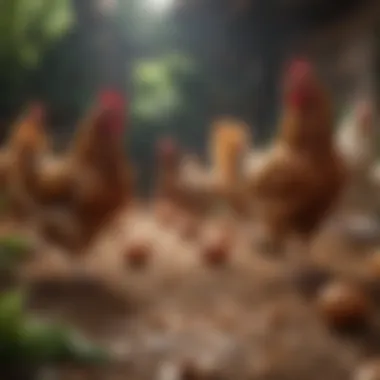
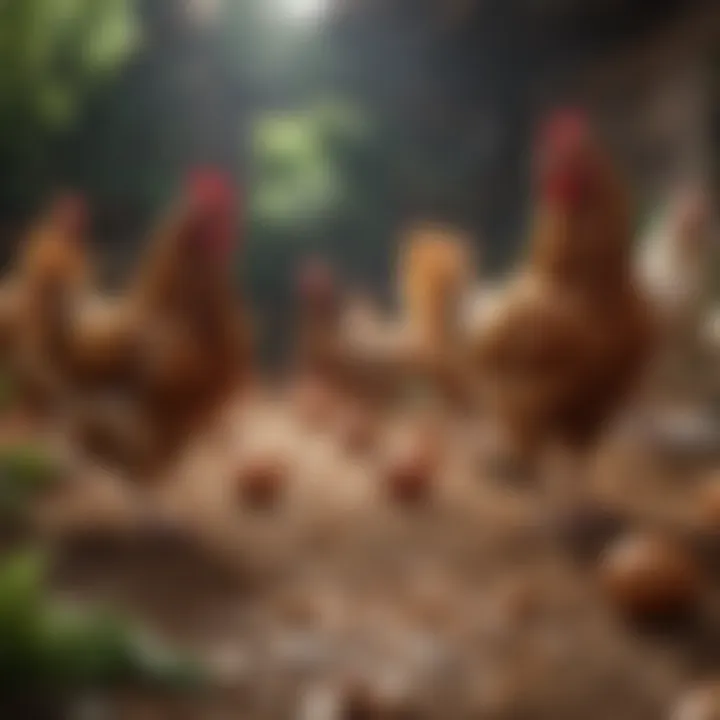
Establishing a robust budget plan allows for not only short-term management but steadfast growth in your chicken-keeping ventures.
Cost-saving Strategies for Chicken Feed
Feeding chickens can eat away at your budget if you don't approach it with a clear strategy. Cost-saving strategies are essential not only to cut down on expenses but also to ensure a sustainable feeding practice. By implementing smart money-saving techniques, chicken owners can maximize their resources and still provide their birds with nutritious feed. Ultimately, this approach can boost overall productivity—whether it be through egg production or meat quality.
Bulk Purchasing Benefits
Buying feed in bulk can be a game changer for chicken owners looking to save some cash. When you purchase larger quantities, you often get significant discounts. Not only does this reduce the cost per pound of feed, but it also ensures you always have enough on hand, preventing last-minute trips to the store.
Here are a few key points to consider about bulk purchasing:
- Cost Efficiency: Often, buying in bulk can lower the overall cost significantly compared to purchasing smaller bags. This can add up over time.
- Convenience: Fewer trips to the store means you spend less time and fuel driving back and forth, which translates to more time focusing on other aspects of chicken care.
- Storing Feed: While bulk feed storage can raise concerns about spoilage or contamination, investing in proper bins or sealed storage can mitigate these risks effectively.
Homemade Feed Alternatives
Making your own chicken feed is not only a fun project but can often lead to savings as well. When you control the ingredients, you can customize the feed to fit the specific needs of your flock while avoiding processed options that can be costly.
Using kitchen scraps
One popular homemade option is using kitchen scraps. This is where you can get creative! Chickens can munch on a wide variety of leftovers, from vegetable peelings to stale bread. By repurposing scraps, you minimize waste while also keeping your flock happy.
Key characteristic: Kitchen scraps allow you to recycle food waste, making it an environmentally friendly option.
- Benefits: You reduce disposal costs at the same time you cut down on feed costs. Plus, chickens love the variety, which can lead to happier birds.
- Unique feature: Chickens can digest many leftovers, so it opens up many possibilities to save on traditional feed costs. However, you should still ensure that these scraps do not amount to unacceptable levels of sugars, salt, or processed ingredients.
Growing supplemental grains
Growing your own grains can also be an effective alternative for those looking to reduce feed costs. Depending on your space and resources, crops like oats, barley, or even sunflowers can be grown specifically for your flock.
Key characteristic: This method allows you to cultivate an organic supply of feed, potentially reducing dependence on commercial feed sources.
- Contributing factor: Growing supplemental grains gives you control over your feed’s nutritional quality and variety.
- Advantages and disadvantages: While the initial setup may require more time and effort, the long-term savings can be significant. However, it’s crucial to acknowledge some challenges as growing grains needs proper conditions and may also come with costs for seeds, water, and maintenance.
In the end, adopting cost-saving strategies effectively enables chicken owners to balance their budgets while ensuring their flock gets the nourishment it deserves.
Evaluating the Investment in Chicken Nutrition
Feeding chickens isn’t just about tossing some grain their way. It’s a thought-out investment that can make all the difference in their health and productivity. First, consider the significant role proper nutrition plays in overall poultry health. These birds depend on their diet to grow, lay eggs, and fend off illness. Quality feed means healthy chickens, which translates into better production rates. Once you think about it, investing in good chicken nutrition can pay off down the line.
Health Benefits of Proper Feeding
So, why is proper feeding crucial? Well, a chicken’s diet can affect their immune system, susceptibility to diseases, and even the quality of the eggs they lay. When chickens receive balanced nutrients, it promotes strong bones, healthy feathers, and robust overall health. A nutritious diet helps keep chickens active and resistant to common ailments. For instance, layers fed a diet rich in calcium produce stronger eggshells, which reduces the chances of breakage—saving both time and money.
- Nutritional Components: Vitamins, minerals, and protein sources such as alfalfa or soymeal can boost chicken health.
- Disease Prevention: Foods rich in antioxidants may help ward off diseases, enhancing longevity.
- Weight Management: Balanced diets help maintain healthy body condition, crucial for breeding birds.
In essence, feeding chickens properly is like providing them an insurance policy against health issues. When you see your flock thriving, you'll know your investment is worth it!
Return on Investment: Eggs and Meat Production
When considering the monetary side of things, the return on investment for proper chicken nutrition can’t be ignored. Quality feed leads to enhanced egg production and improved meat quality. Think about it this way: if you invest a bit more in the feed upfront, you reap the benefits through increased egg yields and better meat.
- Higher Egg Yield: Chickens on specialized layers' feed can produce significantly more eggs compared to those on standard feed.
- Better Quality Meat: Meat chickens fed a carefully balanced diet gain weight more efficiently and produce better quality meat, which can denote higher market prices.
- Long-term Growth: A well-fed chicken will typically have improved growth rates, reaching market size in less time, ultimately reducing the cost-per-pound.
"Investing in high-quality chicken nutrition leads to a ripple effect of benefits that reaches far beyond the barnyard."
If you're raising chickens for profit, the right feed makes it a no-brainer when calculating cost versus income. When your animals are healthy, they not only help keep your operation running smoothly but also provide you with the best possible returns.
In summary, prioritizing nutrition leads not only to happy chickens but also ensures that your investment in their sustenance is rewarded with both abundance and quality.
Culmination: Making Informed Feeding Decisions
In the realm of poultry care, understanding feeding costs and making informed nutrition decisions is paramount. With several aspects to consider—ranging from the choice of feed types to storage solutions—chicken owners can significantly influence their birds' health and productivity.
Importance of Assessing Feeding Costs
Proper feed can mean the difference between a flourishing flock and one that struggles. It's not just a matter of tossing some grains into a trough. Each decision plays a crucial role in your chickens’ overall well-being and their output of eggs or meat.
When you wrap your head around the intricate details of feeding, from nutritional value to economic viability, you enable yourself to maximize the benefits while minimizing unnecessary expenses. This calculated approach allows you to create a sustainable feeding practice that not only keeps your flock healthy but also supports your budget.
Key Considerations
- Evaluate Your Needs: Consider the age, type, and purpose of your chickens. Layers may require different feed compared to broilers.
- Research Feed Sources: Look for quality sources of feed that suit your flock. This might mean local suppliers or online markets, as prices can vary.
- Think Beyond the Basics: Supplements can enhance your flock's health and productivity, even if they come at an extra cost.
- Budget Wisely: Creating a feeding budget involves understanding seasonal fluctuations in prices and planning for bulk purchases where possible.
Consider this:
"A well-fed chicken lays better eggs and stays healthier, which not only leads to a more productive farm but can also bolster morale for those who care for them."
Emotional and Financial Benefits
Feeding decisions impact your emotional satisfaction as a chicken owner too. When you see your birds thriving, it brings a sense of accomplishment. This emotional investment, combined with the financial prudence of well-informed choices, contributes to a successful venture.
Ultimately, the journey towards making informed decisions doesn’t conclude with a budget. It evolves with experience and ongoing learning about the best practices for poultry nutrition. Engaging with fellow chicken owners through forums, like reddit.com, can also provide insights and tips from varied experiences.
In summary, making informed feeding decisions isn't just about what's on the menu; it's about fostering a healthy relationship between the care provider and the animals. The focus should always be on enhancement—their health and your experience as a chicken keeper.















